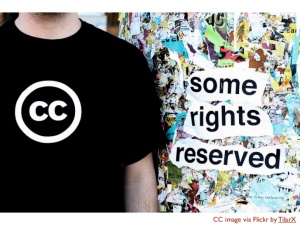To share, or not to share…that seems to be the question. I have encountered a number of lecturers / teachers who are extremely ‘protective’ of their work; I am not referring to their research or articles for publication, but rather to their notes, slides, images, activities or other resources they have developed for their students. Perhaps one of the reasons academics may be reluctant to share their work, especially in a digital space, is based on a lack of understanding of the rules that apply for protecting material that is either created, or made available, online.
Creative Commons licenses allow us to connect and share with others while still being able to exercise control over how this sharing can take place. Creative Commons is not the opposite of Copyright; it does not create a ‘free-for-all’ situation where ‘anything goes’ – instead it allows us to share our work with others while still being acknowledged as the originator of the work. It also allows us access to a wealth of ideas expressed by others that we can use to enhance our own work. There are a range of CC licenses that allow you to select the ‘degree of sharing’ that best suits you.
It’s really all about creativity and connection, access and control; Creative Commons offers us a bridge, a safe passage to a world of collaboration and sharing – “we have to move away from thinking about content to thinking about community” (2008).
Please watch: A Shared Culture (2008).
Director: Jesse Dylan
Producers: Michelle Meier and Priscilla Cohen


Thanks for writing about the much misunderstood Creative Commons, Liesl! It is true that many of us assume that the Creative Commons are the polar opposite of Copyrights and never venture deeper into understanding the different kinds of licensing options available. Perhaps it is time that we make these issues a part of our ‘offline’ and/or ‘mainstream’ curriculum as well?
LikeLike
I can’t but agree with you that sharing in multiple ways is at the core of education, but I wonder how you are working with communities as an educator/teacher. And how do you work with OER’s, I might ask as well, as CC and open licences in my view can change texts, images and sounds/music into educational resources that can be shared. I think both communities and OER’s are relevant to reflect on as part of open educational practices.
LikeLike
I also agree that sharing under CC-licenses is a good way to go, and as you say it’s important to stress the fact that it actually makes things clearer using a CC-license. And if you want to support sharing it’s easy to put the “share alike” option when you decide your CC-license. To get others you use it, we all need to talk about it more. Before this topic on the ONL I knew about Creative Commons and have used pictures under the license, but was a bit reluctant to license things myself. Not that I’m against sharing, but simply because I felt insecure about what the different options actually meant. Now things are clearer and I already started to spread information and readings to my colleagues about it. So in other words – spread the word!
LikeLike